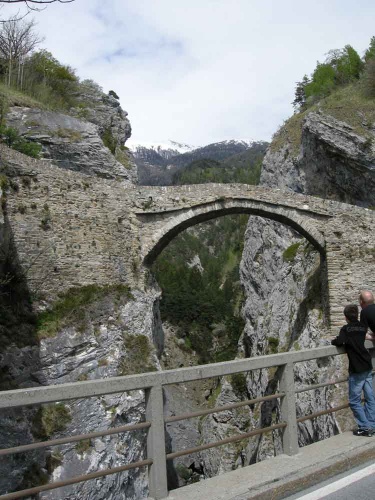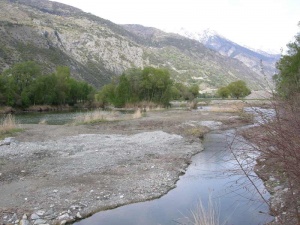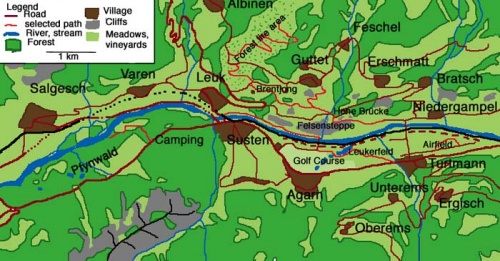Overview
The Leukerfeld is a part of the valley ground between Leuk and Turtmann in the canton Wallis (or Valais) in southwest Switzerland. The Leukerfeld and its surroundings (Pfynwald, Felsensteppe, Hohe Brücke, forest fire area above Leuk) is a great place for mediterranean-alpine birding in Switzerland. This site can be combined with Leukerbad where it's easily possible to see most alpine species.
Birds
The best months are April and May (maybe also early June). The breeding species have arrived then and especially in April and early May many interesting migrants can be found as well. In winter some alpine species can be found as well like Alpine Accentor or Red-billed Chough which are higher up in spring and summer.
The chances to see Wallcreeper are very good. In the plain you will certainly find European Stonechat, Whinchat, Eurasian Wryneck, European Bee-eater, with some luck Eurasian Hoopoe, Western Honey Buzzard, Common Quail, Common Whitethroat and maybe migrants like Red-throated Pipit or Greater Short-toed Lark. Red-footed Falcons often stay here some days in early May. At the Felsensteppe Rock Bunting is easy, Ortolan Bunting more difficult. At Hohe Brücke Eurasian Crag Martin is breeding too. In the Pfynwald species like Black Woodpecker, Eurasian Woodcock, Eurasian Nightjar and Common Sandpiper are breeding. Finally the forest fire area above Leuk offers easy views of Common Redstarts and Rock Bunting.
Rarities
A nice list of mostly southern rarities in the last few years: Calandra Lark, Squacco Heron, Little Crake, Black-winged Stilt, European Roller, Subalpine Warbler, Western Orphean Warbler and many more.
Check-list
Birds you can see here include:
Mallard, Common Quail, Rock Partridge, Little Grebe, Great Cormorant, Little Bittern, Black-crowned Night Heron, Squacco Heron, Little Egret, Great Egret, Grey Heron, Purple Heron, Lammergeier, European Honey Buzzard, Black Kite, Red Kite, Bearded Vulture, Short-toed Eagle, Western Marsh Harrier, Montagu's Harrier, Northern Goshawk, Eurasian Sparrowhawk, Common Buzzard, Short-toed Eagle, Golden Eagle, Common Kestrel, Red-footed Falcon, Peregrine Falcon, Eurasian Hobby, Water Rail, Spotted Crake, Little Crake, Common Moorhen, Common Coot, Little Ringed Plover, Common Snipe, Eurasian Woodcock, Common Sandpiper, Black-headed Gull, Common Wood Pigeon, Eurasian Collared Dove, European Turtle Dove, Common Cuckoo, Long-eared Owl, Tawny Owl, Eurasian Scops-Owl, Eurasian Nightjar, Common Swift, Alpine Swift, Common Kingfisher, European Bee-eater, Eurasian Hoopoe, Green Woodpecker, Black Woodpecker, Great Spotted Woodpecker, Eurasian Skylark, Lesser Short-toed Lark, Wood Lark, Eurasian Crag Martin, Barn Swallow, Northern House Martin, Tawny Pipit, Red-throated Pipit, Water Pipit, Meadow Pipit, Tree Pipit, Yellow Wagtail (mainly cinereocapilla), Grey Wagtail, White Wagtail, White-throated Dipper, Eurasian Wren, Hedge Accentor, Alpine Accentor, Common Nightingale, European Robin, Black Redstart, Common Redstart, European Stonechat, Whinchat, Northern Wheatear, Rufous-tailed Rock Thrush (now rare), Eurasian Blackbird, Fieldfare, Song Thrush, Mistle Thrush, Great Reed Warbler, Sedge Warbler, Eurasian Reed Warbler, Marsh Warbler, Melodious Warbler, Lesser Whitethroat, Garden Warbler, Blackcap, Subalpine Warbler, Western Bonelli's Warbler, Wood Warbler, Willow Warbler, Common Chiffchaff, Goldcrest, Firecrest, Spotted Flycatcher, Marsh Tit, Crested Tit, Coal Tit, Blue Tit, Great Tit, Wood Nuthatch, Wallcreeper, Eurasian Treecreeper, Eurasian Golden Oriole, Red-backed Shrike, Eurasian Magpie, Eurasian Jay, Yellow-billed Chough, Red-billed Chough, Carrion Crow, Common Raven, Common Starling, House Sparrow, Eurasian Tree Sparrow, Chaffinch, European Serin, European Greenfinch, European Goldfinch, Eurasian Siskin, Eurasian Linnet, Hawfinch, Eurasian Bullfinch, Yellowhammer, Rock Bunting, Ortolan Bunting, Cirl Bunting
Site Information
History and Use
Historically the valley was a big marsh. After the cultivation the land was still not used heavily. Nowadays a new golf course and the construction of a new motorway are altering the fields and meadows again. Most parts, except the Pfynwald, are not protected.
Areas of Interest
Leukerfeld
The meadows, fields and ponds of the Leukerfeld are interesting for breeding and migrating species. The ponds hold sometimes up to six species of herons and migrating warblers. Tawny Pipits and Red-throated Pipits can be found in the fields in late April. Access is from Susten. Follow the road from the Leuk train station to the golf course. Follow the yellow signs to Turtmann which leads you to the ponds and through the fields to Turtmann. At the eastern end of the ponds is a small hide and an observation hill. From here you can observe the colony of European Bee-eaters from May to early July. More than 10 adult birds were present in 2013. It's also possible to cross the bridge over the river Rhone. In the small forest on the other side many Common Nightingales are singing and Melodious Warbler is possible too. From there you can go back to Leuk through the Felsensteppe or you go right to Getwing and up to the Hohe Brücke.
Turtmann (Airfield)
The former military airfield of Turtmann is now open for public and freely accessible. The meadows and fields around it hold interesting species. Red-backed Shrike breeds, Eurasian Wryneck and Common Hoopoe can be found too. Especially in late April and May Lesser Short-toed Larks may be found in the fields and sometimes other interesting migrants.
Felsensteppe
The northern slope of the valley has a unique flora and is called Felsensteppe (cliff steppe). There are several ways to explore this habitat. One is the path on the northern side of the river from the bridge at the lower end of the Feschel gorge to Leuk. Another possibility is the path from the Hohe Brücke down to the valley. Just follow the road a bit in direction to Bratsch and go down on the right side. Rock Bunting is breeding here, Ortolan Bunting sometimes. At dusk European Nightjar can be heard. Bonelli's Warbler is quite common and sometimes in summer Short-toed Eagles are seen. Rarities like Subalpine Warbler are always possible in April and May. Botanists and entomologists will find many rare species here too.
Hohe Brücke
The Hohe Brücke (=High Bridge) are in fact two bridges over the Feschel gorge. They're on the way from Leuk to the small village of Bratsch. You can also reach them by foot from the plain (small path going up west of Niedergampeln) or from Brentjong, just follow the yellow signs to Hohe Brücke. It's worth to spend some time here, especially on the old bridge. Wallcreeper breeds here and can be seen all year round. Eurasian Crag Martins also breed, Common Kestrel too and sometimes Peregrine Falcon passes overhead. In winter Red-billed Chough, Yellow-billed Chough and Alpine Accentor can be seen too.
Brentjong
The huge satellite station of Brentjong can be seen from all over the valley. You can reach it by car from Leuk (road to Guttet and Feschel) or by bus. The bus to Leukerbad stops at the junction to Brentjong from where you reach the station in 10 minutes. One possibility is to walk from here to the Hohe Brücke, just follow the yellow signs shortly after the station, leading to the right. Cirl Bunting, Rock Bunting, Eurasian Wryneck or Eurasian Hoopoe may be found here. Common Raven, Peregrine Falcon, Crested Tit or Golden Eagles high in the air are other species which may be seen here.
Forest fire area above Leuk
2003 a frustrated local wanted some revenge and set fire to a forest. He created the biggest forest fire in Switzerland for centuries and the trees burnt down from the bottom of the valley up to the treeline. Now nature is coming back and so are the birds: Common Redstart is the most common bird here! Rock Buntings are everywhere, Citril Finches breed, European Serin and Tree Pipit can be found too. Rufous-tailed Rock Thrush used to breed here but has left the area now as it has overgrown too much for this species, however one or two pairs are still found. Rock Partridge is scarce and can be found in April and May in early morning. In summer Short-toed Eagles are sometimes seen over the slope and bred in 2012. You can reach the area also from the satellite station Brentjong. From the parking follow the road up to Guttet and go left after about 150m. Several paths lead into the area from there.
Pfynwald
The biggest pine forest in Switzerland and the only place where the Rhone can flow freely is the Pfynwald or Foret de Finges (Forest of Pfyn). A good access is the camping near Susten. From there you can go down to the floodplain. European Nightjar can be heard at night, Black Woodpecker seen at day. In spring watch out for displaying Eurasian Woodcocks at the forest edge at dusk. The area is also famous for its plants.
Access and Facilities
To explore all sites you need at least three days. If you have less concentrate on Leukerfeld, Hohe Brücke and Felsensteppe.
You can reach the area by car from Geneva or Lausanne or from Bern and Zurich (you have to load your car on a train through the Lötschberg). But with the new tunnel the train is by far the fastest way to reach Leuk and its surroundings. Getting around can be more challenging. A bicycle is very helpful in the Leukerfeld, Turtmann or the Pfynwald. In Leuk you can hire bicycles at the train station. However at the slopes (Brentjong, Hohe Brücke, Felsensteppe) a bicycle can't be used. This areas can be reached by car or by bus from Leuk.
Accomodation is plentiful in Leuk, Susten and some other villages. There are no big hotels but some nice and small pensions and some camping grounds.
There is no problem anywhere with access. You can use any path you see, unless there is a sign who tells you different. The only problem now is the construction of the motorway A9, so some paths and small streets may be closed. Don't enter the fields or meadows! The farmers don't like it and some of the local cows can be dangerous as they are raised to be fighting cows! (Just cow against cow, no matadors or so...).








